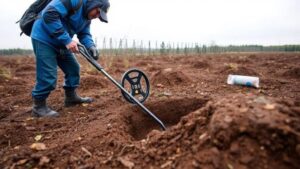Unearthing Stone and Shell Tools in Desert Washes and Arroyos
Unearthing Stone and Shell Tools in Desert Washes and Arroyos
The study of ancient tools made from stone and shell offers critical insights into the lives of prehistoric peoples. In arid landscapes such as desert washes and arroyos, these artifacts provide a record of adaptation, resource management, and cultural practices. This article explores the methods for locating these tools, their significance, and the challenges faced in these environments.
The Geomorphology of Desert Washes and Arroyos
Desert washes and arroyos are ephemeral waterways that serve as conduits for rain runoff in arid regions. r unique geomorphology results in specific sedimentation patterns, making these areas rich in archaeological artifacts. The term arroyo typically refers to a dry creek bed that fills with water during rains, while wash describes a broader area where water flows irregularly.
These formations often expose layers of sediment that can date back thousands of years. Researchers have noted that such sites contain not only stone tools but also remnants of shell tools, as shells were utilized by Indigenous peoples for various applications, including utensil-making and ornamentation.
Significance of Stone and Shell Tools
Stone and shell tools are crucial for understanding human adaptation to desert environments. Several key points illustrate their significance:
- Technological Insights: Tools provide evidence of the technology available to ancient peoples. For example, the presence of bifacially flaked stone tools indicates advanced manufacturing techniques comparable to other prehistoric cultures.
- Resource Utilization: The variety of materials–stone types such as obsidian, chert, and local granite, along with marine shells–indicates complex trade networks and resource management strategies.
- Cultural Practices: The tools found often correlate with burial sites or habitation areas, shedding light on social structures and daily practices.
Locating Artifacts: Methods and Challenges
Excavation and survey techniques play a vital role in the discovery of these artifacts in desert washes and arroyos. Common methods include:
- Pedestrian Surveys: Archaeologists conduct systematic walks, recording and collecting artifacts visible on the surface. This method is effective in areas with minimal vegetation.
- Shovel Testing: Excavating small test pits allows researchers to assess the subsurface for potential artifact presence. This approach is crucial in washes where sediment depth can vary significantly.
- Remote Sensing: Technologies such as LiDAR and ground-penetrating radar help identify anomalies in the landscape that may indicate buried artifacts or features.
But, these methodologies come with challenges. The harsh desert environment often results in high temperatures and difficult terrain. Also, the intermittent nature of water flow in these areas can rapidly erode strata, leading to the loss of valuable contexts. For example, critical sites in the Sonoran Desert have been compromised by flash floods, which can displace artifacts and alter archaeological contexts.
Case Studies: Notable Finds
Several significant archaeological projects have shed light on the importance of stone and shell tools in desert settings:
- The Cochise Culture: Archaeological work in southeastern Arizona has unearthed an array of stone tools, indicating sophisticated hunting and gathering techniques utilized by the Cochise culture more than 10,000 years ago.
- Shell Tools of the Salton Sea Region: Excavations around the Salton Sea have revealed shell tools linked to coastal trade, illustrating the long-distance travel and exchange networks marshaled by Indigenous groups.
These examples reflect the diverse applications of found tools, ranging from everyday utility to ceremonial uses, underscoring their integral role in shaping human interaction with the environment.
Actionable Takeaways
For researchers and enthusiasts interested in the study of stone and shell tools in desert landscapes, several actionable steps can be taken:
- Develop Local Frameworks: Collaborate with local tribes and historical societies to create a shared understanding of the significance of these artifacts.
- Engage in Conservation: Participate in efforts to protect critical wash and arroyo sites from erosion and development that jeopardizes archaeological integrity.
- Use Modern Techniques: Leverage advances in technology for remote sensing and excavation to enhance discovery efforts while minimizing environmental impact.
Ultimately, the ongoing efforts to unearth stone and shell tools in desert washes and arroyos not only uncover artifacts but also illuminate the resilience and ingenuity of ancient societies in arid environments.



